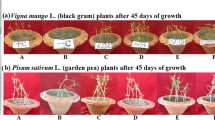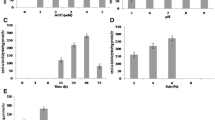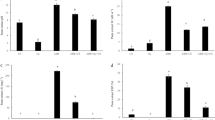Abstract
Physiological characteristics of terrestrial plants are severely affected by waterlogging stress, leading to low photochemical efficiency of leaves and retarded growth and development. Plant growth-promoting rhizobacteria contain the acdS gene, which encodes for the enzyme 1-aminocyclopropane-1-carboxylate (ACC) deaminase. ACC deaminase cleaves the substrate ACC to produce α-ketobutyrate and ammonia and mitigates the adverse effect of prolonged water stress. The aim of this study was to characterize ACC deaminase-producing rhizobacteria and evaluate their effects on sesame (Sesamum indicum L.) under waterlogging stress condition. The rhizobacterium Pseudomonas KJ was characterized on the basis of sequencing of the partial 1501 bp fragment of 16S rDNA amplicon and confirmed as Pseudomonas veronii KJ. ACC-supplemented minimal medium revealed the phenotypic identification of acdS gene. The nucleotide sequence (1001 bp) of ACC deaminase gene of P. veronii KJ was also confirmed. We used P. veronii KJ as a bioinoculant in waterlogging stress and monitored the growth and developmental characteristics of sesame plants, including leaf chlorophyll fluorescence signals, concentration of chlorophyll, root and shoot length, and fresh and dry biomass in stressed versus unstressed plants. Plants treated with P. veronii KJ significantly (P ≤ 0.05) mitigated the waterlogging stress-related damage. Thus, the rhizobacterium Pseudomonas veronii KJ may be considered as a commendable addition to the consortium of beneficial microbes for its ability to reduce waterlogging stress-related damage in sesame plants.








Similar content being viewed by others
References
Wei W, Li D, Wang L, Ding X, Zhang Y, Gao Y, Zhang X (2013) Morpho-anatomical and physiological responses to waterlogging of sesame (Sesamum indicum L.). Plant Sci 208:102–111
Couch A, Gloaguen RM, Langham DR, Hochmuth GJ, Bennett JM, Rowland DL (2017) Non-dehiscent sesame (Sesamum indicum L.): its unique production potential and expansion into the southeastern USA. Journal of Crop Improvement 31(2):101–172
Martinchik AN (2011) Nutritional value of sesame seeds. Vopr Pitan 80(3):41–43
Lakhanpaul S, Singh V, Kumar S, Bhardwaj D, Bhat KV (2012) Sesame: overcoming the abiotic stresses in the queen of oilseed crops. Improv Crop Resist Abiotic Stress 1(2):1251–1283
Ullah I, Waqas M, Khan MA, Lee IJ, Kim WC (2017) Exogenous ascorbic acid mitigates flood stress damages of Vigna angularis. Appl Biol Chem 60(6):603–614
Glick BR (2014) Bacteria with ACC deaminase can promote plant growth and help to feed the world. Microbiol Res 169(1):30–39
Morales-Olmedo M, Ortiz M, Selles G (2015) Effects of transient soil waterlogging and its importance for rootstock selection. Chil J Agric Res 75:45–56
Glick BR, Todorovic B, Czarny J, Cheng Z, Duan J, McConkey B (2007) Promotion of plant growth by bacterial ACC deaminase. Crit Rev Plant Sci 26(5–6):227–242
Lee CH, Seo SH, Kwon OJ, Park M, Kim WC, Kang SJ (2016) Functional characterization of a chemical defoliant that activates fruit cluster Leaf defoliation in ‘Fuji’apple trees. Appl Biol Chem 59(5):711–720
Sasidharan R, Hartman S, Liu Z, Martopawiro S, Sajeev N, Van Veen H, Voesenek LA (2018) Signal dynamics and interactions during flooding stress. Plant Physiol 176(2):1106–1117
Singh RP, Shelke GM, Kumar A, Jha PN (2015) Biochemistry and genetics of ACC deaminase: a weapon to “stress ethylene” produced in plants. Front Microbiol 6:937
Glick BR (2012) Plant growth-promoting bacteria: mechanisms and applications. Scientifica. https://doi.org/10.6064/2012/963401
Honma M, Shimomura T (1978) Metabolism of 1-aminocyclopropane-1-carboxylic acid. Agric Biol Chem 43:1825–1831
Kalaji HM, Jajoo A, Oukarroum A, Brestic M, Zivcak M, Samborska IA, Ladle RJ (2016) Chlorophyll a fluorescence as a tool to monitor physiological status of plants under abiotic stress conditions. Acta Physiol Plant 38(4):102
Smethurst CF, Shabala S (2003) Screening methods for waterlogging tolerance in lucerne: comparative analysis of waterlogging effects on chlorophyll fluorescence, photosynthesis, biomass and chlorophyll content. Funct Plant Biol 30(3):335–343
Justin SHFW, Armstrong W (1987) The anatomical characteristics of roots and plant response to soil flooding. New Phytol 106(3):465–495
Valentini R, Epron D, Angelis PD, Matteucci G, Dreyer E (1995) In situ estimation of net CO2 assimilation, photosynthetic electron flow and photorespiration in Turkey oak (Q. cerris L.) leaves: diurnal cycles under different levels of water supply. Plant Cell Environ 18(6):631–640
Grichko VP, Glick BR (2001) Amelioration of flooding stress by ACC deaminase-containingplant growth-promoting bacteria. Plant Physiol Biochem 39(1):11–17
Buchanan E, Gibbons NE, Stewart WDP (1994) Bergeys manual of determinative bacteriology (edited by R. Solar Energy) 24: 607–616
Dworkin M, Foster JW (1958) Experiments with some microorganisms which utilize ethane and hydrogen. J Bacteriol 75:592–601
Penrose DM, Glick BR (2003) Methods for isolating and characterizing ACC deaminase containing plant growth promoting rhizobacteria. Physiol Plant 118(1):10–15
Giovannoni SJTB, Britschgi CL, Moyer Field KG (1990) Genetic diversity in Sargasso Sea bacterioplankton. Nature 345:60–63
Tamura K, Stecher G, Peterson D, Filipski A, Kumar S (2013) MEGA6: molecular evolutionary genetics analysis version 6.0. Mol Biol Evol 30(12):2725–2729
Gitelson AA, Buschmann C, Lichtenthaler HK (1999) The chlorophyll fluorescence ratio F735/F700 as an accurate measure of the chlorophyll content in plants. Remote Sens Environ 69(3):296–302
Björkman O, Demmig B (1987) Photon yield of O2 evolution and chlorophyll fluorescence characteristics at 77 K among vascular plants of diverse origins. Planta 170(4):489–504
Farwell AJ, Vesely S, Nero V, Rodriguez H, McCormack K, Shah S, Glick BR (2007) Tolerance of transgenic canola plants (Brassica napus) amended with plant growth-promoting bacteria to flooding stress at a metal-contaminated field site. Environ Pollut 147(3):540–545
Nascimento F, Brígido C, Alho L, Glick BR, Oliveira S (2012) Enhanced chickpea growth-promotion ability of a Mesorhizobium strain expressing an exogenous ACC deaminase gene. Plant Soil 353(1–2):221–230
Glick BR, Penrose DM, Li J (1998) A model for the lowering of plant ethylene concentrations by plant growth-promoting bacteria. J Theor Biol 190(1):63–68
Li J, Ovakim DH, Charles TC, Glick BR (2000) An ACC deaminase minus mutant of Enterobacter cloacae UW4No longer promotes root elongation. Curr Microbiol 41(2):101–105
Hall JA, Peirson D, Ghosh S, Glick BR (1996) Root elongation in various agronomic crops by the plant growth promoting rhizobacterium Pseudomonas putida GR12–2. Isr J Plant Sci 44(1):37–42
Shaharoona B, Arshad M, Zahir ZA, Khalid A (2006) Performance of Pseudomonas spp. containing ACC-deaminase for improving growth and yield of maize (Zea mays L.) in the presence of nitrogenous fertilizer. Soil Biol Biochem 38(9):2971–2975
Khandelwal A, Sindhu SS (2013) ACC deaminase containing rhizobacteria enhance nodulation and plant growth in Clusterbean (Cyamopsis tetragonoloba L.). J Microbiol Res 3(3):117–123
Drancourt M, Bollet C, Carlioz A, Martelin R, Gayral JP, Raoult D (2000) 16S ribosomal DNA sequence analysis of a large collection of environmental and clinical unidentifiable bacterial isolates. J Clin Microbiol 38(10):3623–3630
Glick BR, Jacobson CB, Schwarze MM, Pasternak JJ (1994) 1-Aminocyclopropane-1-carboxylic acid deaminase mutants of the plant growth promoting rhizobacterium Pseudomonas putida GR12-2 do not stimulate canola root elongation. Can J Microbiol 40(11):911–915
Castonguay Y, Nadeau P, Simard RR (1993) Effects of flooding on carbohydrate and ABA levels in roots and shoots of alfalfa. Plant, Cell Environ 16:695–702
Rogers ME (2001) The effect of saline irrigation on Lucerne production: shoot and root growth, ion relations and flowering incidence in six cultivars grown in Northern Victoria, Australia. Irrig Sci 20:55–64
Forghani AH, Almodares A, Ehsanpour AA (2018) Potential objectives for gibberellic acid and paclobutrazol under salt stress in sweet sorghum (Sorghum bicolor [L.] Moench cv. Sofra). Appl Biol Chem 61(1):113–124
Acknowledgments
This work was carried out with the support of Cooperative Research Program for Agriculture Science & Technology Development (Project No. PJ012286042018) Rural Development Administration, Republic of Korea.
Author information
Authors and Affiliations
Corresponding author
Rights and permissions
About this article
Cite this article
Ali, S., Khan, M.A. & Kim, WC. Pseudomonas veronii KJ mitigates flood stress-associated damage in Sesamum indicum L.. Appl Biol Chem 61, 575–585 (2018). https://doi.org/10.1007/s13765-018-0392-2
Received:
Accepted:
Published:
Issue Date:
DOI: https://doi.org/10.1007/s13765-018-0392-2




